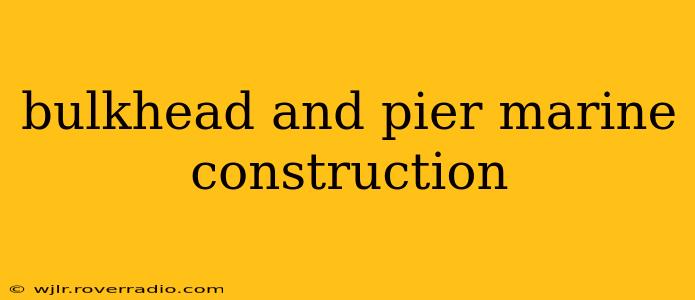Marine construction projects, particularly those involving bulkheads and piers, are complex undertakings requiring specialized knowledge and expertise. This guide delves into the intricacies of bulkhead and pier construction, addressing common questions and offering insights into the design, materials, and construction processes involved. Understanding these aspects is crucial for ensuring the longevity and structural integrity of these vital waterfront structures.
What is a bulkhead in marine construction?
A bulkhead in marine construction is a retaining structure, typically made of reinforced concrete, steel sheet piling, or timber, that is built to hold back the earth and prevent erosion along a waterfront. It essentially creates a stable boundary between land and water, protecting the shoreline from the erosive forces of waves and currents. Bulkheads are often used to create a level surface for development, providing a foundation for buildings, docks, or other waterfront structures. Their design must account for water pressure, soil conditions, and anticipated wave action.
What is a pier in marine construction?
A pier, also known as a wharf or dock, is an extended structure projecting out into a body of water, providing access for boats and ships. Piers provide a platform for loading and unloading cargo and passengers. They can be constructed from various materials, including concrete, steel, and timber, and their design depends heavily on the intended use, anticipated loads, and environmental conditions. Pier construction often involves pilings driven deep into the seabed to provide a stable foundation.
What are the different types of bulkheads?
Bulkheads are categorized based on their construction materials and design:
- Concrete Bulkheads: Durable and long-lasting, these are often chosen for their strength and resistance to the elements. They can be constructed in-situ (cast-in-place) or precast.
- Steel Sheet Pile Bulkheads: These are composed of interlocking steel sheets driven into the ground, creating a strong and relatively flexible barrier. They are suitable for sites with varying soil conditions.
- Timber Bulkheads: While more traditional and potentially less durable than concrete or steel, timber bulkheads can be a cost-effective option for smaller projects, especially in areas with readily available timber resources. However, they require regular maintenance.
What are the different types of piers?
Pier types vary based on their purpose, construction, and location:
- Fixed Piers: These are permanently anchored structures, offering stable platforms for docking and loading/unloading operations.
- Floating Piers: These structures float on the water's surface, using pontoons or other buoyant elements for support. They are commonly used in areas with fluctuating water levels or where a fixed pier is impractical.
- Gravity Piers: These structures rely on their own weight for stability, often constructed from large concrete blocks or similar heavy materials.
What are the key considerations in bulkhead and pier design?
Several crucial factors must be considered during the design phase of bulkhead and pier projects:
- Soil Conditions: A thorough geotechnical investigation is necessary to understand the soil's properties and bearing capacity. This informs the foundation design and material selection.
- Water Depth and Currents: The depth of the water and the strength of currents dictate the design of the foundation and the overall structure's resistance to hydrodynamic forces.
- Wave Action: The anticipated wave height and frequency influence the design, particularly the structural strength and stability of both bulkheads and piers.
- Environmental Regulations: Marine construction projects are subject to various environmental regulations aimed at protecting water quality and marine habitats. Compliance is crucial.
- Intended Use: The specific purpose of the structure (e.g., recreational boating, commercial shipping) heavily influences its design and specifications.
How long does it take to build a bulkhead or pier?
The construction timeline for bulkheads and piers varies significantly depending on several factors, including the project's size and complexity, site conditions, material selection, and the availability of labor and equipment. Smaller projects may take weeks, while larger, more complex ones could take months or even years to complete.
What are the costs associated with bulkhead and pier construction?
The cost of bulkhead and pier construction is highly variable, influenced by factors such as location, project size, materials used, and labor costs. It's crucial to obtain detailed cost estimates from experienced marine contractors, factoring in all aspects of the project, including design, permitting, materials, labor, and contingency.
How are bulkheads and piers maintained?
Regular inspection and maintenance are vital to extending the lifespan of both bulkheads and piers. This includes checking for structural damage, corrosion, erosion, and any signs of deterioration. Regular cleaning, repainting, and repairs are essential to prevent significant problems and ensure long-term functionality.
This comprehensive guide provides a foundational understanding of bulkhead and pier marine construction. Always consult with experienced marine engineers and contractors for detailed project planning and execution. Remember, the safety and longevity of these structures are paramount.
